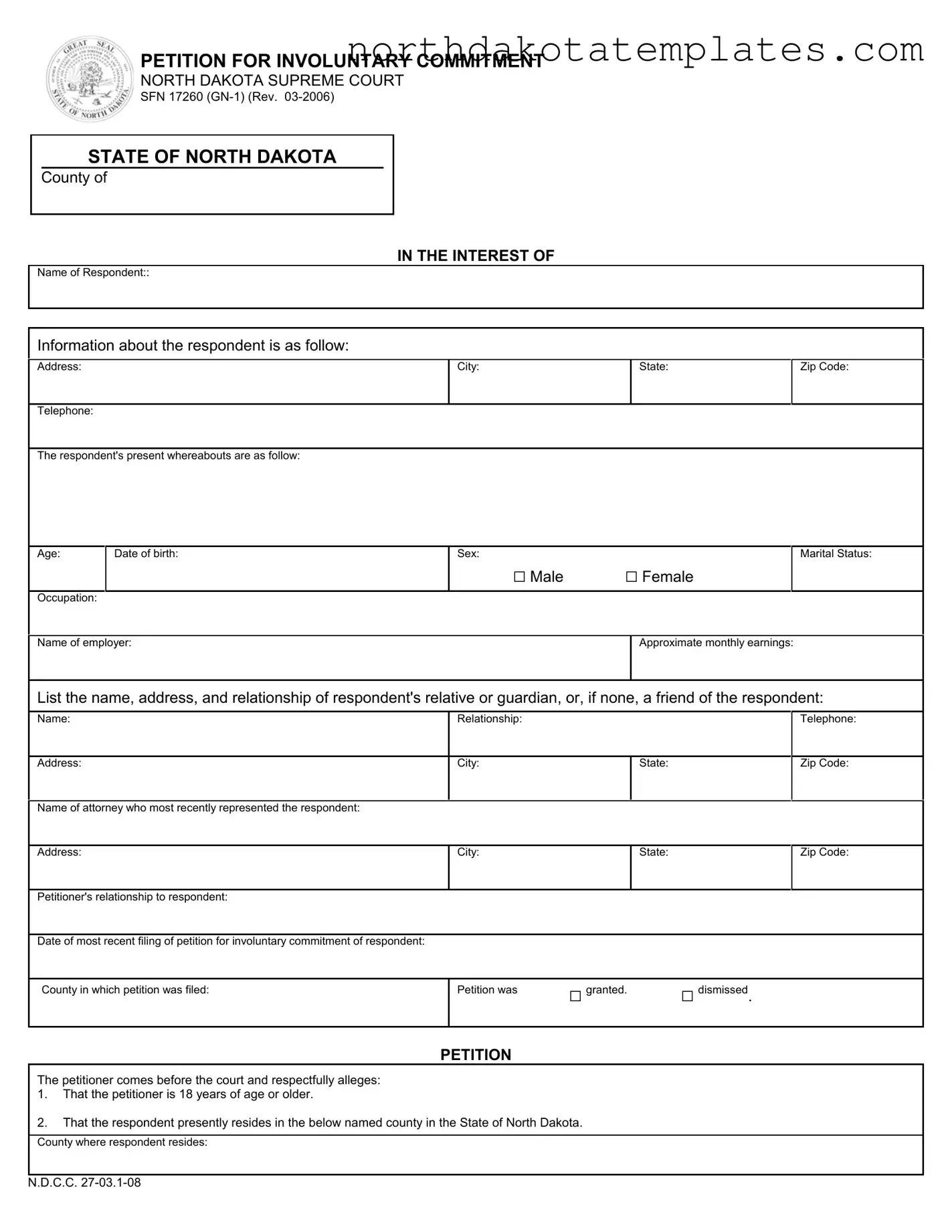
PETITION FOR INVOLUNTARY COMMITMENT
NORTH DAKOTA SUPREME COURT
SFN 17260 (GN-1) (Rev. 03-2006)
STATE OF NORTH DAKOTA
County of
IN THE INTEREST OF
Name of Respondent::
Information about the respondent is as follow:
Address: |
|
City: |
|
State: |
|
Zip Code: |
|
|
|
|
|
|
|
Telephone: |
|
|
|
|
|
|
|
|
|
|
|
|
|
The respondent's present whereabouts are as follow: |
|
|
|
|
|
|
|
|
|
|
|
|
Age: |
Date of birth: |
Sex: |
|
|
|
Marital Status: |
|
|
G Male |
G Female |
|
|
|
|
|
|
|
|
Occupation: |
|
|
|
|
|
|
|
|
|
|
Name of employer: |
|
|
Approximate monthly earnings: |
|
|
List the name, address, and relationship of respondent's relative or guardian, or, if none, a friend of the respondent: |
|
|
|
|
|
|
|
Name: |
|
Relationship: |
|
|
|
Telephone: |
|
|
|
|
|
|
|
Address: |
|
City: |
|
State: |
|
Zip Code: |
|
|
|
|
|
|
Name of attorney who most recently represented the respondent: |
|
|
|
|
|
|
|
|
|
|
|
|
Address: |
|
City: |
|
State: |
|
Zip Code: |
|
|
|
|
|
|
Petitioner's relationship to respondent: |
|
|
|
|
|
|
|
|
|
|
|
Date of most recent filing of petition for involuntary commitment of respondent: |
|
|
|
|
|
|
|
|
|
County in which petition was filed: |
Petition was |
G granted. |
G dismissed. |
|
|
|
|
|
|
|
PETITION
The petitioner comes before the court and respectfully alleges:
1.That the petitioner is 18 years of age or older.
2.That the respondent presently resides in the below named county in the State of North Dakota.
County where respondent resides:
North Dakota Supreme Court |
|
SFN 17260 (GN-1) (Rev. 03-2006) |
Page 2 |
3.That the petitioner believes that the respondent is
G mentally ill and as a result of such condition there is a reasonable expectation of a serious risk of harm if respondent is not treated.
G chemically dependent and as a result of such condition there is a reasonable expectation of a serious risk of harm if respondent is not treated.
4.That because of the foregoing condition, the respondent requires treatment.
5.That the assertions contained in paragraph 3 are based upon the following specific facts (attach additional sheets, if necessary):
6.That the names, addresses, and telephone numbers of witnesses who will verify these facts are as follows:
7. That petitioner believes that G is G is not necessary to take the respondent into immediate custody and emergency treatment. [Immediate custody should be requested only if the respondent is seriously mentally impaired or chemically dependent and is imminently likely to injure the respondent or other persons if allowed to remain at liberty.]
8.[Complete only if immediate custody and emergency treatment requested.] Overt act(s) of the respondent which indicate the respondent is likely to injure themself or other persons if allowed to remain at liberty are described as follows:
9.That to the petitioner's best knowledge G The respondent is indigent.
G The respondent is not indigent.
The petitioner believes that an evaluation of the respondent's condition should be made and involuntary commitment and treatment is required.
North Dakota Supreme Court |
|
SFN 17260 (GN-1) (Rev. 03-2006) |
Page 3 |
|
|
State of North Dakota |
) |
)ss.
County of ________________________)
The undersigned, being first sworn, on their oath states that the undersigned is the petitioner in the above matter, and that the facts in this petition are true to the affiant's best information and belief
X____________________________________________________________
Petitioner
Dated this ________ day of ____________________ of ________, before me personally appeared ______________________________________________
______________________________________________ who having been sworn state that to the best of their knowledge and belief the statements in this
petition are true.
X____________________________________________________________
Notary Public
(Seal)
My commission expires __________________________________________
APPROVAL OF ATTORNEY
This petition was reviewed for probable cause and I approve the filing of the petition.
Dated this ________ day of __________________ of ________.
X______________________________________________________________
Attorney
_______________________________________________________________
County



